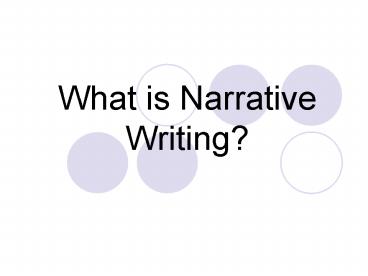What is Narrative Writing? PowerPoint PPT Presentation
1 / 14
Title: What is Narrative Writing?
1
What is Narrative Writing?
2
What Is a Short Story?
- A short story is a brief, made-up narrative an
account of a sequence of events. - Most short stories have
- 1. One or more characters
- 2. A conflict or problem that keeps the reader
asking, What will happen next? - 3. A beginning that grabs the readers interest
and introduces the characters, setting, and
conflict. - 4. A middle in which the story reaches a climax-
its turning point. - 5. An ending in which the conflict is resolved
and loose ends are tied up.
3
Types of Short Stories
- 1. Realistic stories take you on a walk through
familiar neighborhoods with people much like
those you know. - 2. Fantasy and science-fiction stories might
whisk you away to strange, new planets or
mysterious ancient kingdoms. - 3. Adventure stories tumble you into a world of
brave heroes fighting dangerous enemies.
4
Prewriting
- A. Choosing Your Topic For some writers,
telling a story is easy- the hard part is coming
up with a good topic. - B. Developing Narrative Elements Identify the
Conflict - 1. Conflict is a struggle between two opposing
forces. - 2. External Conflict occurs when a character is
struggling against an outside forces such as
another character or a natural event. - 3. Internal Conflict takes place within a
character, as when the character struggles to
make a tough decision or to overcome fear.
5
- C. Considering Your Audience and Purpose
- 1. Audience Who your readers are
- A. Young Children, use simpler words than if you
were writing a story for older readers. - B. People who dont go to your school, remember
that if you mention something particular to your
school, such as a certain teacher, you must
explain who or what you are talking about. - 2. Purpose What you want to do for them
- A. Make readers laugh, select funny details to
include - B. give readers goosebumps, include a couple of
surprises. - C. Present a theme (a question or message
about,) use events that illustrate the question
or message.
6
- D. Gathering Details
- Gather details to include in your story.
- List ideas about your story topic.
- Put in chronological order
7
Drafting
- A. Shaping Your Writing Plot is the arrangement
of events in the story. - 1. The exposition introduces the characters and
their situation, including the central conflict. - 2. This conflict develops and intensifies during
the rising action, which leads to the climax. - 3. The climax, or turning point of the story,
might take form of an argument or moment of
decision. - 4. In the storys falling action, events start
winding down, leading to the resolution. - 5. At the resolution, the conflict is resolved
in some way and loose ends are tied up.
8
- Show a Plot Diagram Page 82
9
- B. Providing Elaboration
- As you draft your story, make your characters and
setting come alive by including sensory
details-language that describes how things look,
sound, feel, taste, and smell.
10
Revising
- A. Revising Your Overall Structure
- Create Logical Connections Between Events
- B. Revising Your Paragraphs
- 1. Show, Dont Tell (Tell how they walk
(quickly) Tell how their voice sounds
(trembling)) - 2. Add Dialogue
- A. A characters answer or response to another
character. - B. Information one character gives another
- C. An order, command, or instruction given by a
character. - D. A question a character asks.
- E. Something a character says to express
feelings.
11
- C. Revising Your Sentences
- Provide Transitions Words that show the
connection between ideas. - D. Revising Your Word Choice
- Use vivid verbs chuckled, snorted, blossomed
into, and sounded - E. Peer Review
- 1. Make notes on the parts they like
- 2. Make notes on parts that need more details
12
Editing and Proofreading
- Proofread your story carefully to catch errors in
spelling, punctuation, capitalization, and
grammar. - Pay particular attention to proofreading your
storys dialogue-speech that youve quoted
exactly. Make sure youve punctuated it
correctly. (Page 89 Rules)
13
Publishing and Presenting
- 1. To Be Graded
- 2. To Share
- 3. Memory Folder
14
- Narrative Short Story Pages 72-90

